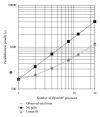Large-scale modeling of epileptic seizures: scaling properties of two parallel neuronal network simulation algorithms
- PMID: 24416069
- PMCID: PMC3876705
- DOI: 10.1155/2013/182145
Large-scale modeling of epileptic seizures: scaling properties of two parallel neuronal network simulation algorithms
Abstract
Our limited understanding of the relationship between the behavior of individual neurons and large neuronal networks is an important limitation in current epilepsy research and may be one of the main causes of our inadequate ability to treat it. Addressing this problem directly via experiments is impossibly complex; thus, we have been developing and studying medium-large-scale simulations of detailed neuronal networks to guide us. Flexibility in the connection schemas and a complete description of the cortical tissue seem necessary for this purpose. In this paper we examine some of the basic issues encountered in these multiscale simulations. We have determined the detailed behavior of two such simulators on parallel computer systems. The observed memory and computation-time scaling behavior for a distributed memory implementation were very good over the range studied, both in terms of network sizes (2,000 to 400,000 neurons) and processor pool sizes (1 to 256 processors). Our simulations required between a few megabytes and about 150 gigabytes of RAM and lasted between a few minutes and about a week, well within the capability of most multinode clusters. Therefore, simulations of epileptic seizures on networks with millions of cells should be feasible on current supercomputers.
Figures





Similar articles
-
A configurable simulation environment for the efficient simulation of large-scale spiking neural networks on graphics processors.Neural Netw. 2009 Jul-Aug;22(5-6):791-800. doi: 10.1016/j.neunet.2009.06.028. Epub 2009 Jul 2. Neural Netw. 2009. PMID: 19615853
-
Meeting the memory challenges of brain-scale network simulation.Front Neuroinform. 2012 Jan 24;5:35. doi: 10.3389/fninf.2011.00035. eCollection 2011. Front Neuroinform. 2012. PMID: 22291636 Free PMC article.
-
Comparison of GPU- and CPU-implementations of mean-firing rate neural networks on parallel hardware.Network. 2012;23(4):212-36. doi: 10.3109/0954898X.2012.739292. Epub 2012 Nov 9. Network. 2012. PMID: 23140422
-
Update on the mechanisms and roles of high-frequency oscillations in seizures and epileptic disorders.Epilepsia. 2017 Aug;58(8):1330-1339. doi: 10.1111/epi.13830. Epub 2017 Jul 6. Epilepsia. 2017. PMID: 28681378 Free PMC article. Review.
-
Toward a Mechanistic Understanding of Epileptic Networks.Curr Neurol Neurosci Rep. 2016 Nov;16(11):97. doi: 10.1007/s11910-016-0701-2. Curr Neurol Neurosci Rep. 2016. PMID: 27662895 Review.
Cited by
-
Synchronization of coupled different chaotic FitzHugh-Nagumo neurons with unknown parameters under communication-direction-dependent coupling.Comput Math Methods Med. 2014;2014:367173. doi: 10.1155/2014/367173. Epub 2014 Jun 30. Comput Math Methods Med. 2014. PMID: 25101140 Free PMC article.
References
-
- Banks DL. Statistical data mining. Wiley Interdisciplinary Reviews: Computational Statistics. 2010;2(1):9–25.
-
- Efron B. Large-scale simultaneous hypothesis testing: the choice of a null hypothesis. Journal of the American Statistical Association. 2004;99(465):96–104.
-
- Gerstner W, Sprekeler H, Deco G. Theory and simulation in neuroscience. Science. 2012;338(6103):60–65. - PubMed
Publication types
MeSH terms
Grants and funding
LinkOut - more resources
Full Text Sources
Other Literature Sources
Medical

